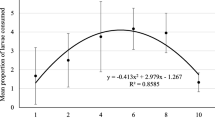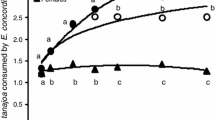Abstract
Predation by a predator complex consisting of adults of the lygaeidGeocoris punctipes (Say), the nabidsNabis roseipennis Reuter and/orTropiconabis capsiformis Germar and the coccinelids,Hippodamia convergens Guerin-Meneville andColeomegilla maculata (DeGeer) onHeliothis virescens (F.) eggs, 1st-instar larvae or both on late pinhead square and early bloom stage cotton was evaluated in field cages in Mississippi. Prey densities of 4 (11, 512/ha) or 8 per cage and predator: prey (P:p) ratios of 1∶1, 2∶1, 3∶1, 4∶1 and 5∶1 were used. Prey were labeled with phosphorus-32 or carbon-14 to determine predator ingestion and effectiveness. Average percent egg predation as a function of P:p ratio ranged from 2.1 to 12.1 for a 48 h period. The average percent predation on larvae as a function of P:p ratio ranged from 5.3 to 22.0. The hemiptera fed more than the coleoptera on larvae, andG. punctipes was the best egg predator. For the range of predator densities used, the average area of discovery for the predator complex was 6.98 × 10−3 m/day and 2.34 × 10−2 m/day when exposed to eggs and larvae, respectively.
Résumé
Dans des cages situées en plein air, on a étudié au Mississippi la prédation due à un complexe de prédateurs constitué d'adultes du lygacide:Geocoris punctipes say, des Nabides:Nabis roseipennis Reuter et/ouTropicanabis capsiformis Germar et des coccinellidesHippodamia convergens Guerin-Meneville etColeomegilla maculata (DeGeer), sur les œufs et les ler stades larvaires d'Heliothis virescens ou les 2 sur le stade phénologique du coton bouton blanc et début de floraison.
Les densités de proies de 4 (11, 512/ha) ou de 8 par cage et des rapports prédateurs/proies (P:p) de 1∶1; 2∶1; 3∶1; 4∶1 et 5∶1, ont été utilisés. Les proies ont été marquées au P32 ou au C14 pour déterminer la capacité d'ingestion du prédateur et son efficacité. Le pourcentage moyen de destruction des œufs, en fonction du rapport P:p, s'échelonnait de 2,1 à 12,1 pour une période de 48 h. Le pourcentage moyen de destruction des larves en fonction du rapport P:p, s'échelonnait de 5,3 à 22,0. Les hemipteis plus que les coléoptères se nourissaient des larves etG. punctipes était le meilleur prédateur oophage. Pour l'échelle de densités des prédateurs employés, la surface moyenne de découverte pour le complexe prédateur était de 6,98 × 10−3, mètres/jour avec comme proies les œufs et 2,34 × 10−2 mètres/jour avec comme proies les larves.
Similar content being viewed by others
References
Bryson, C. T. &Schuster, M. F. — 1975. Effectiveness of a spotted lady beetle as predator of the bollworm on cotton. —J. Econ. Entomol., 68, 273.
Donahoe, M. C. &Pitre, H. N. — 1977.Reduviolus roseipennis behavior and effectiveness in reducing numbers ofHeliothis zea on cotton. —Environ. Entomol., 6, 872–876.
Ewert, M. A. &Chiang, H. C. — 1966. Dispersal of three species of coccinellids in corn fields. —Can. Entomol., 98, 999–1003.
Hillhouse, T. L. &Pitre, H. N. — 1976. Oviposition byHeliothis on soybean and cotton. —J. Econ. Entomol., 69, 144–146.
Hogg, D. B. &Nordheim, E. V. — 1983. Age-Specific survivorship analysis ofHeliothis spp. populations on cotton. —Res. Popul. Ecol., 25, 280–297.
Hutchison, W. D. &Pitre, H. N. — 1983. Predation ofHeliothis virescens [Lepidoptera: Noctuidae] eggs byGeocoris punctipes [Hemiptera: Lygaeidae] adults on cotton. —Environ. Entomol., 12, 1652–1656.
Kogan, M. &Pitre, H. N. — 1980. General sampling methods for above ground populations of soybean arthropods pp. 30–60. In: Sampling Methods in Soybean Entomology (M. Kogan &D. C. Herzog, eds.). —Springer-Verlag, N. Y., 582 pp.
Lingren, P. D., Ridgway, R. L. &Jones, S. L. — 1968. Consumption by several common arthropod predators of eggs and larvae of twoHeliothis species that attack cotton. —Ann. Entomol. Soc. Am., 61, 613–618.
Mahlin, D. T. &Lofberg, R. T. — 1966. A simplified method of sample preparation for determination of tritium, carbon-14 or sulfur-35 in blood or tissue by liquid scintillation counting. —Anal. Biochem., 16, 500–509.
McDaniel, S. G., Keeley, L. L. &Sterling, W. L. — 1978. RodiolabelingHeliothis virescens eggs by32p injection of adult females. —Ann. Entomol. Soc. Am., 71, 432–434.
McDaniel, S. G. &Sterling, W. L. — 1979. Predator determination and efficiency onHeliothis virescens eggs in cotton using32p. —Environ. Entomol., 8, 1083–1087.
McDaniel, S. G. &Sterling, W. L. — 1982. Predation ofHeliothis virescens (F.) eggs on cotton in east Texas. —Environ. Entomol., 11, 60–66.
McDaniel, S. G., Sterling, W. L. &Dean, D. A. — 1981. Predators of tobacco budworm larvae in Texas cotton. —The Southwestern Entomologist., 6, 102–108.
Nettles, W. C., Jr. — 1982. Contact stimulants fromHeliothis virescens that influence the behavior of females of the tachinid,Eucelatoria bryani. —J. Chem. Ecol., 8, 1183–1191.
Scanlan, S. M. — 1979. Behavior and feeding effectiveness ofGeocoris punctipes on cotton. —M. S. Thesis, Mississippi State University., 57 pp.
Snedecor, G. W. &Cochran, W. G. — 1980. Statistical methods. —The Iowa State University Press, Ames., 507 pp.
Thead, L. G., Pitre, H. N. &Kellogg, T. F. — 1985. Feeding behavior of adultGeocoris punctipes (Say) [Hemiptera: Lygaeidae] on nectaried and nectariless cotton. —Environ. Entomol., 14, 134–137.
Thead, L. G. Pitre, H. N. &Kellogg, T. F. — 1987. Phosphorus-32 bioelimination by arthropod predators fed labeled eggs ofHeliothis virescens [Lep.: Noctuidae]. —Entomophaga, 32, 191–195.
Varley, G. C., Gradwell, G. R. & Hassell, M. P., — 1973. Insect Population Ecology: An Analytical Approach. —Univ. of Calif. Press. 212 pp.
Author information
Authors and Affiliations
Additional information
Publication No 5936-Mississippi Agricultural and Forestry Experiment Station, Mississippi State, MS 39762.
Rights and permissions
About this article
Cite this article
Thead, L.G., Pitre, H.N. & Kellogg, T.F. Predation on eggs and larvae ofHeliothis virescens [Lep.: Noctuidae] by an adult predator complex in cage studies on cotton. Entomophaga 32, 197–207 (1987). https://doi.org/10.1007/BF02373131
Received:
Accepted:
Issue Date:
DOI: https://doi.org/10.1007/BF02373131




